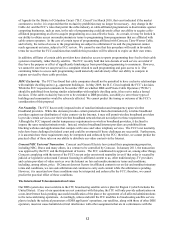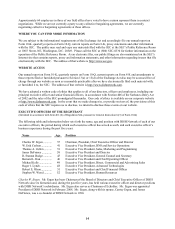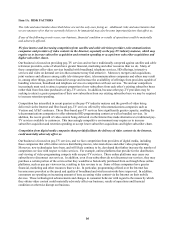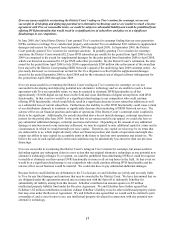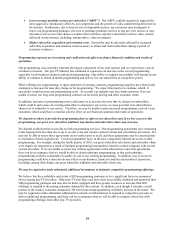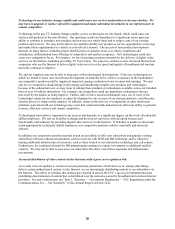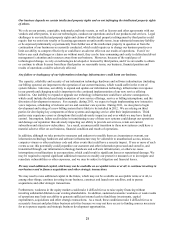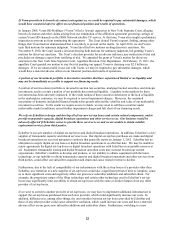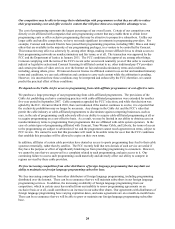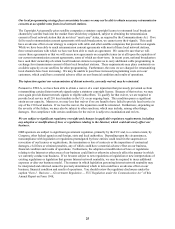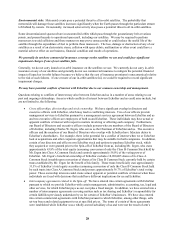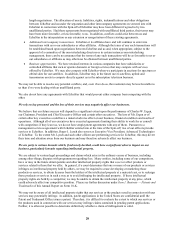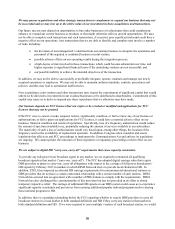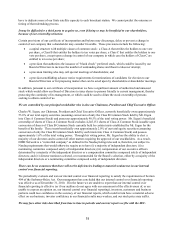Dish Network 2010 Annual Report Download - page 28
Download and view the complete annual report
Please find page 28 of the 2010 Dish Network annual report below. You can navigate through the pages in the report by either clicking on the pages listed below, or by using the keyword search tool below to find specific information within the annual report.
21
21
Our business depends on certain intellectual property rights and on not infringing the intellectual property rights
of others.
We rely on our patents, copyrights, trademarks and trade secrets, as well as licenses and other agreements with our
vendors and other parties, to use our technologies, conduct our operations and sell our products and services. Legal
challenges to our intellectual property rights and claims of intellectual property infringement by third parties could
require that we enter into royalty or licensing agreements on unfavorable terms, incur substantial monetary liability
or be enjoined preliminarily or permanently from further use of the intellectual property in question or from the
continuation of our businesses as currently conducted, which could require us to change our business practices or
limit our ability to compete effectively or could have an adverse effect on our results of operations. Even if we
believe any such challenges or claims are without merit, they can be time-consuming and costly to defend and divert
management’s attention and resources away from our business. Moreover, because of the rapid pace of
technological change, we rely on technologies developed or licensed by third parties, and if we are unable to obtain
or continue to obtain licenses from these third parties on reasonable terms, our business, financial position and
results of operations could be adversely affected.
Any failure or inadequacy of our information technology infrastructure could harm our business.
The capacity, reliability and security of our information technology hardware and software infrastructure (including
our billing systems) are important to the operation of our current business, which would suffer in the event of
system failures. Likewise, our ability to expand and update our information technology infrastructure in response
to our growth and changing needs is important to the continued implementation of our new service offering
initiatives. Our inability to expand or upgrade our technology infrastructure could have adverse consequences,
which could include the delayed implementation of new service offerings, service or billing interruptions, and the
diversion of development resources. For example, during 2011, we expect to begin implementing new interactive
voice response, scheduling of in-home service and customer care systems. During 2011, we also plan to begin
development and testing of a new billing system that is likely to be installed in 2012. We are relying on third
parties for developing key components of these systems and ongoing service after their implementation. Third
parties may experience errors or disruptions that could adversely impact us and over which we may have limited
control. Interruption, failure and/or delay in transitioning to any of these new systems could disrupt our operations
and damage our reputation thus adversely impacting our ability to provide our services, retain our current
subscribers and attract new subscribers. As a result, an unsuccessful transition to these new systems could have a
material adverse effect on our business, financial condition and results of operations.
In addition, although we take protective measures and endeavor to modify them as circumstances warrant, our
information technology hardware and software infrastructure may be vulnerable to unauthorized access, misuse,
computer viruses or other malicious code and other events that could have a security impact. If one or more of such
events occur, this potentially could jeopardize our customer and other information processed and stored in, and
transmitted through, our information technology hardware and software infrastructure, or otherwise cause
interruptions or malfunctions in our operations, which could result in significant losses or reputational damage. We
may be required to expend significant additional resources to modify our protective measures or to investigate and
remediate vulnerabilities or other exposures, and we may be subject to litigation and financial losses.
We may need additional capital, which may not be available on acceptable terms or at all, to continue investing in
our business and to finance acquisitions and other strategic transactions.
We may need to raise additional capital in the future, which may not be available on acceptable terms or at all, to
among other things, continue investing in our business, construct and launch new satellites, and to pursue
acquisitions and other strategic transactions.
Furthermore, weakness in the equity markets could make it difficult for us to raise equity financing without
incurring substantial dilution to our existing shareholders. In addition, sustained economic weakness or weak results
of operations may limit our ability to generate sufficient internal cash to fund these investments, capital
expenditures, acquisitions and other strategic transactions. As a result, these conditions make it difficult for us to
accurately forecast and plan future business activities because we may not have access to funding sources necessary
for us to pursue organic and strategic business development opportunities.



